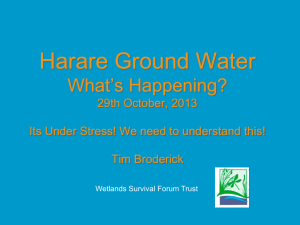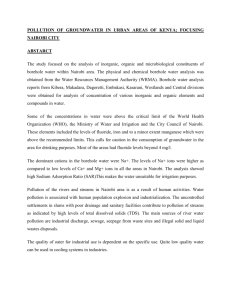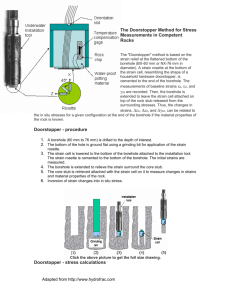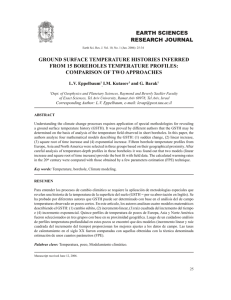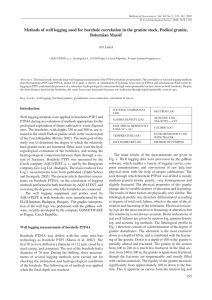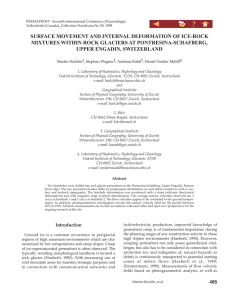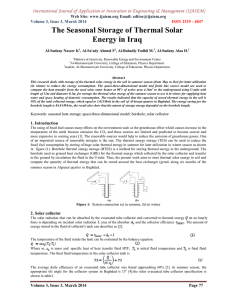ANTPASlastversionprotocol
advertisement
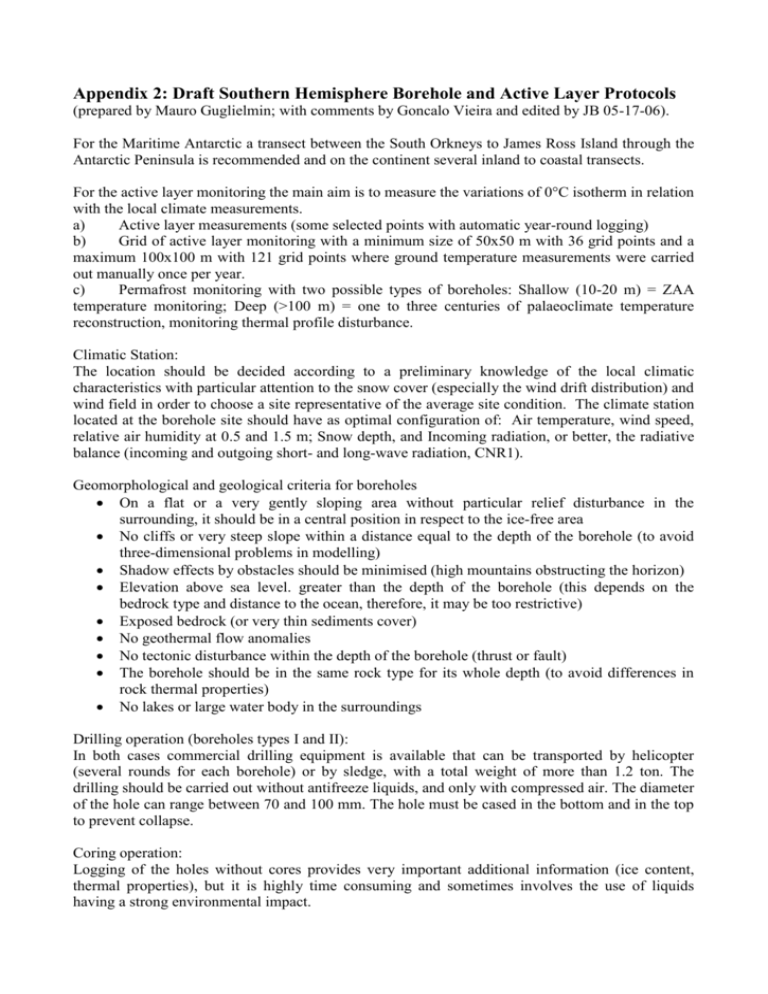
Appendix 2: Draft Southern Hemisphere Borehole and Active Layer Protocols (prepared by Mauro Guglielmin; with comments by Goncalo Vieira and edited by JB 05-17-06). For the Maritime Antarctic a transect between the South Orkneys to James Ross Island through the Antarctic Peninsula is recommended and on the continent several inland to coastal transects. For the active layer monitoring the main aim is to measure the variations of 0°C isotherm in relation with the local climate measurements. a) Active layer measurements (some selected points with automatic year-round logging) b) Grid of active layer monitoring with a minimum size of 50x50 m with 36 grid points and a maximum 100x100 m with 121 grid points where ground temperature measurements were carried out manually once per year. c) Permafrost monitoring with two possible types of boreholes: Shallow (10-20 m) = ZAA temperature monitoring; Deep (>100 m) = one to three centuries of palaeoclimate temperature reconstruction, monitoring thermal profile disturbance. Climatic Station: The location should be decided according to a preliminary knowledge of the local climatic characteristics with particular attention to the snow cover (especially the wind drift distribution) and wind field in order to choose a site representative of the average site condition. The climate station located at the borehole site should have as optimal configuration of: Air temperature, wind speed, relative air humidity at 0.5 and 1.5 m; Snow depth, and Incoming radiation, or better, the radiative balance (incoming and outgoing short- and long-wave radiation, CNR1). Geomorphological and geological criteria for boreholes On a flat or a very gently sloping area without particular relief disturbance in the surrounding, it should be in a central position in respect to the ice-free area No cliffs or very steep slope within a distance equal to the depth of the borehole (to avoid three-dimensional problems in modelling) Shadow effects by obstacles should be minimised (high mountains obstructing the horizon) Elevation above sea level. greater than the depth of the borehole (this depends on the bedrock type and distance to the ocean, therefore, it may be too restrictive) Exposed bedrock (or very thin sediments cover) No geothermal flow anomalies No tectonic disturbance within the depth of the borehole (thrust or fault) The borehole should be in the same rock type for its whole depth (to avoid differences in rock thermal properties) No lakes or large water body in the surroundings Drilling operation (boreholes types I and II): In both cases commercial drilling equipment is available that can be transported by helicopter (several rounds for each borehole) or by sledge, with a total weight of more than 1.2 ton. The drilling should be carried out without antifreeze liquids, and only with compressed air. The diameter of the hole can range between 70 and 100 mm. The hole must be cased in the bottom and in the top to prevent collapse. Coring operation: Logging of the holes without cores provides very important additional information (ice content, thermal properties), but it is highly time consuming and sometimes involves the use of liquids having a strong environmental impact. It is recommended to collect 1-2 samples (at the beginning and at the end) of the borehole with a diamond bites core auger. If the purpose is also to investigate the biologic content of permafrost within sediment, all the borehole should be drilled using a triple core auger (T6) with included plastic liner that can prevent part of the contamination. This kind of coring is almost impossible through boulders or bedrock so, it is better to drill through the block and continue the coring below these obstructions. Temperature monitoring: Shallow boreholes should be closed at the top without any concrete or metal caps which could change the surface characteristics. These boreholes can be used also to monitor the 0°C isotherm depth and therefore the thermal string should be built with more thermal probes near the permafrost table and ZAA). There are two procedures for standardizing the monitoring: 1) Establish the depths of measurement after some preliminary manual thermal measurements choosing the more representative depths of permafrost table and ZAA and some fixed depths (e.g. 2 cm, 30 cm, in the upper part, 10 m, 15 m, 20 m). 2) Establish a common fixed set of depths, e.g.: Continental Antarctic: 0.02, 0.1, 0.2, 0.3, 0.4, 0.5, 0.6, 1.6, 2.6, 3.6, 5.0, 8.0, 10.0, 11.0, 12.0, 13.0, 14.0, 15.0, 16.0, 18.0 and 20.0m; Maritime Antarctic: 0.02, 0.3, 0.5, 1.0, 1.3, 1.6, 1.9, 2.2, 2.6, 3.6, 5.0, 8.0, 10.0, 11.0, 12.0, 13.0, 14.0, 15.0, 16.0, 18.0 and 20.0 m. In this case a shallow borehole should be drilled not more than 10 m away from the deeper one and instrumented as above. The deeper borehole should be instrumented with a fixed depth of 5 or 10 m below the ZAA. Recording interval should be established depending on the depth (hourly in the first 0.3 m, daily from 0.3 m to ZAA; weekly or monthly below, in order to save memory and power). Minimum accuracy of the sensors should be 0.1°C. Active layer: for details see: Guglielmin, M. Ground surface temperature (GST), active layer and permafrost monitoring in continental Antarctica. Permafrost and Periglacial Processes 17: 133-143 (2006). CALM-South should be composed of: 1) Active layer year-round monitoring site 2) Climate station as specified above 3) GRID - The grid (minimum 50x50 m with 36 grid points, maximum 100x100 m with 121 grid points; nodes at 10m spacing) can be marked with wood stakes or metal rods. GPS coordinates of at least the four corners are required. The site should be flat or with very gentle slope (<5° on average) and with the more representative vegetation and grain size (lithology) included. At the first stage, detailed topographic (or GPS) DTM of the GRID should be produced, as well as measurements of albedo, grain size, vegetation, thickness of organic mat for each point. One annual measurement (preferably during the same week every year, and preferably at the time of maximum thaw) of ground temperature at fixed depths (e.g. 2, 10, 20, 30, 50 cm) should be carried out, extrapolating the 0°C isotherm at this point. The snow depth is measured when the ground is covered by snow. Automatic monitoring at a minimum of two points with homogeneous vegetation and soils conditions and additional sites for heterogeneous conditions is recommended. The critical point for installing of the automatic station to monitor the active layer is the choice of the measuring points. It is recommended to employ a time-step procedure in which the first step is to measure manually once per year (or for those who have adequate funding, year round with data loggers) on a grid with enough representative and comparable for 2-3 years and thereafter a “posteriori” analysis to continue with year-round recordings at some selected points.



